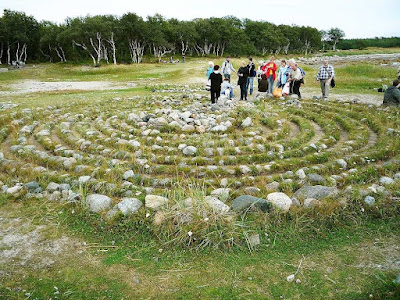New Agers and other Fringies impart great spiritual significance to mazes and labyrinths. Just following the path is supposedly going to make you feel more spiritual. Now I am admittedly a skeptic on many things considered spiritual and certainly no New Ager, but it is also the case that many cultures over the centuries have included related beliefs in their spiritual lives. Among other things, labyrinths and mazes are often used as puzzles where one starts at the outside and attempts to find the center, whether with a pencil on paper or on foot in one of the cornfield mazes currently popular in the fall.
“Labyrinths have been found in just about every major religious tradition in the world, have formed an integral part of many cultures, and have been found on every inhabited continent. At about the same time as the appearance of the Greek labyrinth, an essentially identical pattern appeared in Native American culture, the Tohono O'odham labyrinth, which features I'itoi, the "Man in the Maze". A prehistoric petroglyph on a riverbank in Goa shows the same pattern and other examples have been found among cave art in northern India and on a dolmen shrine in the Nilgiri Mountains. In terms of ancient archaeological monuments, more than 300 examples of labyrinths can be found in various locations around the world. Many questions remain around how the same pattern managed to appear at the same time in apparently disparate cultures.”(Holloway 2014)
There is,
however, one location where the largest concentration of labyrinths in the
world can be found. “Such labyrinths have
been discovered all over the world, but the greatest number of them is
concentrated on the Solovetsky Islands (Arkhangelsk Region) – about 35, with 14
of them on Bolshoi Zayatsky Island. Besides these labyrinths, hundreds of
mounds, piles of boulders and dolmens were also found, which proves that the
archipelago in the White Sea was inhabited in ancient times. It’s known that in
the 1st millennium BC, nomadic Saami tribes lived there, but they
were not the first – the radiocarbon analysis of the objects showed traces of
humans of the 6th-7th millennium BC. The labyrinths
themselves date back to about 1st -2nd millennium BC,
which means that they should have built before the Saami or Proto-Saami people.
But some stone patterns could have been made later too.” (Goldman 2022)
Dating of these remains speculative for the most part, wild guesses ranging
from 30,000 BCE to historical can be found.
“Also, such labyrinths were found on
the islands of the Kuzova Archipelago in Karelia and not far from the town of
Kandalaksha in Murmansk Region, as well as in some areas of Siberia. All of
them are either on islands or in river estuaries, i.e. near water.” (Goldman 2022) It would seem that
there is something in the culture that led to this proliferation of labyrinths.
"All in all, there are 35 labyrinths (known as vavilons - 'Babylons' - in the local dialect) in the Solovetsky Islands. All have been made of local boulders. Excavations in the stone heaps have yielded parts of bones. Measuring between 6 - 25.4 m (20 - 83 ft) in diameter, the labyrinths are mostly made of boulders (c. 30 - 40 cm (12-16 in) in diameter) set in a row. The rows are twisted in the form of a spiral; often there are two spirals set one into another, which has been likened to 'two serpents with their heads in the middle looking at each other." Intermittently along the spiral there are thicker or wider heaps of stones; the ends of the spirals are also wider." (Wikipedia) This complicates the matter even further, heaps of stones and widened ends are design features not shared by all of the labyrinths, so what does that mean?
“Apart from rituals, labyrinths, at least some of them, could also have a purely practical meaning. The Soviet archeologist Nina Gurina, having studied Karelian and Murmansk labyrinths, assumes that they were intended for fishing. The point is that the water level could have been higher centuries ago and such stone traps ‘locked’ the fish without distracting people from other things.” (Goldman 2022) While this might be a possible use it strikes me as unlikely. There are, in fact, much more effective shapes for fish traps that would have involved moving considerably less rock. And what about the ones that are on higher ground that would not have been submerged – and why so many? All questions that I have not found answers to, but an interesting subject for speculation. What do you think?
NOTE: Some images in this posting were retrieved from the internet with a search for public domain photographs. If any of these images are not intended to be public domain, I apologize, and will happily provide the picture credits if the owner will contact me with them. For further information on these reports you should read the original reports at the sites listed below.
REFERENCES:
Goldman, Eleonora, 2022, Mysterious stone labyrinths in the Russian North – what are they?, 15 April 2022, Russia Beyond (online), https://www.rbth.com. Accessed online 28 May 2024/
Holloway, April, 2014, The Ancient Stone Labyrinths of Bolshoi Zayatsky, 14 April 2014, https://www.ancient-origins.net/. Accessed online 28 May 2024.
Wikipedia, Stone labyrinths of Bolshoi Zayatsky Island, https://en.wikipedia.org/. Accessed online
27 May 2024.










No comments:
Post a Comment